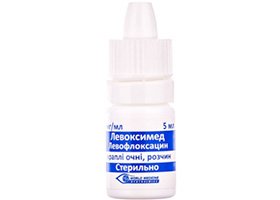
All iLive content is medically reviewed or fact checked to ensure as much factual accuracy as possible.
We have strict sourcing guidelines and only link to reputable media sites, academic research institutions and, whenever possible, medically peer reviewed studies. Note that the numbers in parentheses ([1], [2], etc.) are clickable links to these studies.
If you feel that any of our content is inaccurate, out-of-date, or otherwise questionable, please select it and press Ctrl + Enter.
Levoximed
Medical expert of the article
Last reviewed: 03.07.2025

Levoximed is a medicine used for therapy of ophthalmological pathologies. Contains the element levofloxacin.
 [ 1 ]
[ 1 ]
ATC classification
Active ingredients
Pharmacological group
Pharmachologic effect
Indications Levoximeda
It is used for local treatment of exogenous eye infections of bacterial origin (caused by bacteria sensitive to levofloxacin).
Release form
The medicine is released in the form of eye drops, in dropper bottles with a capacity of 5 ml. There is 1 such bottle inside the box.
Dosing and administration
Drops are used exclusively locally.
It is necessary to instill 1-2 drops into the affected eye at intervals of 2 hours. A maximum of 8 such procedures are allowed per day (during the first 2 days of therapy), and during the period of 3-5 days - 4 procedures per day.
To prevent contamination of the dropper tip, ensure that the pipette does not come into contact with the eyelid or other areas around the eyes.
The duration of therapy is determined by the severity of the infectious process, as well as the bacteriological and clinical course of the pathology. Often, treatment lasts 5 days.
 [ 7 ]
[ 7 ]
Use Levoximeda during pregnancy
Levoximed should not be prescribed to pregnant or breastfeeding women.
Contraindications
It is contraindicated to use drops in the presence of hypersensitivity to levofloxacin or other components of the drug, as well as in case of intolerance to drugs from the quinoline group.
Side effects Levoximeda
Due to the fact that the medication contains benzalkonium chloride, the active element of this preservative can provoke the appearance of irritation or contact eczema. Among other side effects:
- immune lesions: extraocular ocular allergy, manifested as anaphylaxis or rashes;
- disorders affecting the functioning of the nervous system: the appearance of headaches;
- visual impairment: development of burning or mucus strands, visual impairment, swelling of the eyelids, chemosis, matting of the eyelids, a feeling of discomfort or a foreign body in the eyes, papillary conjunctival response, eye pain or itching. In addition, there is also infection in the conjunctiva, dry eyes, photosensitivity, erythema of the eyelids and follicular conjunctivitis;
- symptoms from the organs of the mediastinum and sternum, as well as the respiratory system: pharyngitis, runny nose and swelling in the larynx;
- systemic and administration site disorders: fever.
Overdose
The volume of levofloxacin inside the bottle with drops is too small, so the medicine cannot provoke the development of toxic effects if the solution is accidentally swallowed. If necessary, the patient can undergo an examination and a course of supportive procedures.
In case of local overdose in the eye area, rinse it with plain clean water.
Storage conditions
Levoximed should be kept in a place out of reach of children. Temperature indicators – within 25°С.
 [ 10 ]
[ 10 ]
Shelf life
Levoximed can be used for 3 years from the date of manufacture of the therapeutic agent. An opened bottle has a shelf life of 1 month.
Application for children
The use of the medication in infants under 1 year of age is prohibited.
Analogues
The analogs of the drug are Levofloxacin, Leflocin with Levobax, L-Flox and Lecomak, as well as Loxof and Levoflox, Tigeron, Tavanic and Oftaquix, Glevo, Floracid, Abiflox, Eleflox and Flexid.
Manufacturer
Attention!
To simplify the perception of information, this instruction for use of the drug "Levoximed" translated and presented in a special form on the basis of the official instructions for medical use of the drug. Before use read the annotation that came directly to medicines.
Description provided for informational purposes and is not a guide to self-healing. The need for this drug, the purpose of the treatment regimen, methods and dose of the drug is determined solely by the attending physician. Self-medication is dangerous for your health.

